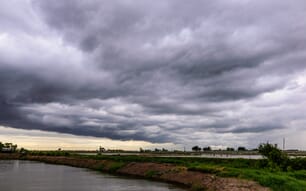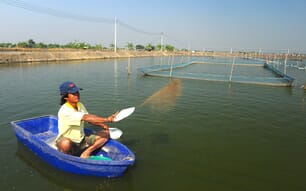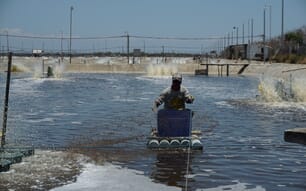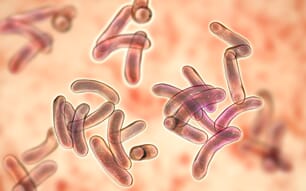Excessive ammonia is one of the biggest challenges to overcome in shrimp aquaculture. As farmers seek to increase profits and intensify production, the problem of ammonia toxicity is more relevant than ever before, leading to high mortality and severe economic losses. This article looks at the impact of ammonia on Pacific white shrimp (Litopenaeus vannamei), and practical ways for farmers to prevent its excessive build-up on their farms.
Ammonia is nitrogenous waste produced from feed input and microbial decomposition of organic matter in water columns. Shrimp feed is usually high in nitrogen. In L vannamei culture, sometimes only 22 percent of the Nitrogen input is converted to harvested shrimp. 57 percent is discharged into the environment and 14 percent remains in the sediment. The microbial decomposition of excess feed, shrimps’ faecal solid, microbial populations and dead phytoplankton all contribute to the ammonia to nitrogen cycle in the culture water.
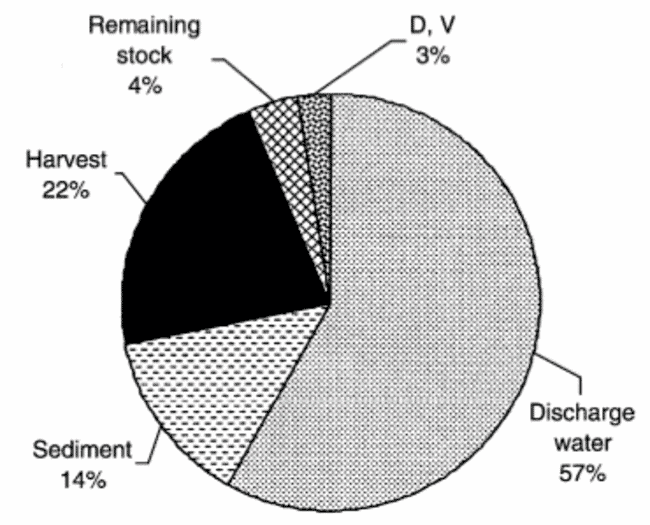
Much of routine aquaculture management is dedicated to controlling the forms and concentration of the total ammonia concentration as nitrogen, or what is usually called total ammonia nitrogen (TAN). TAN is composed of the fractions of two forms of ammonia – namely unionised ammonia (NH3) and ionised ammonium (NH4+). The ionised ammonium is relatively non-toxic while the unionised ammonia is toxic to the cultured shrimp.
How ammonia concentrations impact shrimp
Ammonia is toxic to L vannamei because high concentrations can damage the gill, hepatopancreas and possibly the gut lining. This damage may affect various aspects of shrimp health – such as respiration, metabolism, immunity, osmotic regulation, nutrient absorption, excretion, moulting and growth. As a result of these physiological and immune impacts, high ammonia may allow pathogens to take hold, leading to mortality.
Besides its toxicity, TAN is concerning because of its influence on the carrying capacity of shrimp ponds. The carrying capacity is defined as the maximum biomass of cultured shrimp that the pond can support without breaching the limit of impacts to the cultured organisms and its surrounding environment.
A mathematical analysis undertaken by the team at Alune* on the sensitivity of TAN levels to several parameters – such as stocking density, water exchange rate, nitrification rate, growth rate and mortality rate – found that TAN is most sensitive to stocking density. As illustrated in the figure below, TAN levels tend to increase in higher stocking density.
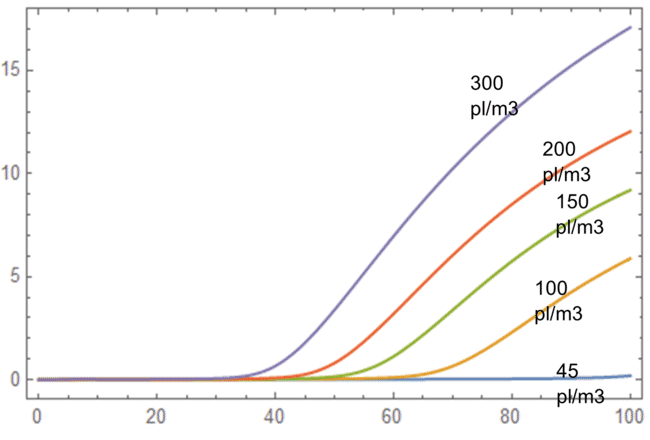
© Alune
Ponds with high stocking densities will feed more and so tend to have higher TAN concentrations over time, which will lead to lower carrying capacity.
As ammonia build-up increases, so too does the total oxygen demand that the organisms in the pond require. This may increase beyond what the pond infrastructure can replenish through photosynthesis or aeration. With elevated ammonia concentrations, the pond environment becomes stressful for the shrimp and leads to lost appetite and growth stagnation.
As illustrated in the chart below, this is when the critical standing crop (CSC) is reached, or a situation when growth slows from the maximum growth line. This would lead to the pond reaching its carrying capacity, or a situation where growth stops completely. High concentrations of TAN could lead ponds to reach their carrying capacity well before the shrimp attain marketable size, reducing revenues for the farm.
.png?width=650&height=0)
© Alune
What drives ammonia toxicity?
The toxicity of ammonia and the equilibrium of unionised to ionised ammonia is driven by factors including pH, temperature, salinity, alkalinity and dissolved oxygen. The ideal pH of water for shrimp aquaculture is between 7 to 8.
The rise of temperature would cause the fraction of unionised ammonia in TAN to increase. This often creates difficult management decisions as optimal growing conditions coincide with higher fractions of NH3 than would be achieved with lower pH and temperatures.
Dissolved oxygen and alkalinity are important as they improve the chemical and physiological process efficiency under stress conditions. They are also vital in supporting the removal of ammonia via the aerobic nitrification processes.
Nitrification is the conversion of ammonia to nitrite and nitrate. Nitrate is comparatively less toxic than ammonia and nitrite. Ammonia is converted into nitrite and then nitrate by nitrifying bacteria. Nitrosomonas bacteria convert ammonia to nitrite and Nitrobacter bacteria convert nitrite to nitrate. Oxygen is required for nitrification to take place and alkalinity of over 120 is recommended to support the growth of nitrifying bacteria. Poor levels of aeration in ponds can cause ammonia build-up to reach toxic levels.
Ways to prevent ammonia build-up
In order to prevent ammonia issues in shrimp ponds, proper management is needed to keep the concentration below the maximum threshold or lethal concentrations. The following are the important parameters for preventing ammonia concentrations increasing.
Weekly measurements
Weekly measurements are recommended, increasing to daily when problems such as disease or low dissolved oxygen occur. Measurements can be taken with easy to use field kits, an on-site laboratory or third party laboratory. It’s recommended that a laboratory test is used occasionally with field tests to check reliability and accuracy. TAN, nitrite and nitrate, alkalinity, DO, salinity and pH should be measured at the same time.

© CP Foods
Feeding regimes
The main source of ammonia in shrimp culture comes from the feed inputs. One way to prevent ammonia build-up is proper feed management through feeding regime planning. Feeding regimes specify the diet, amount and schedule.
The diet refers to specified feed type – eg live feed or artificial feed – and the protein content, which determines the amount of ammonia released into the water. The amount refers to the feeding rate used in the system. Feeding rate must take into account the amount of biomass and target of average daily growth (ADG). While the feeding schedule is the time and portion of the feed at each feed hour.
Feeding regimes need to take into account the needs of shrimp growth and the capacity of the water and pond bottom environment. This is done in order to prevent overfeeding, which leads to ammonia build-up in the water.
Maintaining alkalinity
Alkalinity is a measure of the ability of the water body to neutralise acids and bases and thus maintain a fairly stable pH level and stable water environment. The maximum pH fluctuation should not exceed 0.5. It is important to maintain a stable pH at a safe range because it affects the metabolism and other physiological processes of culture organisms. Optimum alkalinity range is 120-200 ppm.
Keeping pH steady
As explained above, pH is an important factor of ammonia ionisation, which determines the toxicity of the ammonia itself. The pH of culture water should be maintained at the optimum pH range between 7.7 to 8.3 units.
Managing salinity
Salinity affects ionic strength of the culture water, which determines the proportion of ammonia ionisation, which also determines the toxicity of the ammonia itself. A study on P semisulcatus found that salinity determines growth and ammonia tolerance of culture organisms. Therefore, the culture water should be kept at optimum salinity range between 25 to 35 ppt.
Dissolved oxygen
Adequate amounts of dissolved oxygen can help maintain the nitrification process, which is important for removing ammonia from culture water. The nitrification process balances the concentrations of ammonium, nitrate and nitrite for better shrimp growth. The suitable dissolved oxygen range needed to prevent ammonium build up is >5 ppm.
Addressing ammonia problems
As explained above, unionised ammonia (NH3) is toxic to shrimp. The upper limits of NH3 are described in the table below.
.PNG?width=650&height=0)
© Alune
If ammonia concentration in your farm already exceeds the maximum threshold and you see behavioural or physical anomalies – or even mortality – in the cultured shrimp, some important countermeasures are needed. These may act as an immediate treatment and may help to prevent further problems, such as a disease outbreak.
Physical treatment
One of the ways to decrease the ammonia concentrations in shrimp ponds is to dilute the water, usually via water exchange or water circulation. This not only decreases the ammonia concentration but also creates a better environment for the shrimp.
A daily water exchange of 10 to 40 percent from the total volume of water can be done until ammonia concentrations reach a safe level. A thorough water management SOP should be applied when exchanging water, especially where water exchange exceeds 15 percent.
Increasing nitrification rate
The ammonia build-up might be caused by a low nitrification rate. To combat this, the nitrification rate can be increased by adding nitrifying bacteria from commercial products. This will lead to an increase in nitrite, which while less toxic than NH3, is still toxic and other management plans should be applied in combination with other therapies.
Increasing alkalinity
The increase in ammonia could be caused by the fluctuation of pH levels, which is caused by low alkalinity. If the alkalinity is low, add about 12.5 ppm bicarbonate compounds such as CaO, CaCO, CaMg(CO3) or NaHCO to the water every two to three days until the alkalinity reaches the optimum range of 120 to 200ppm.
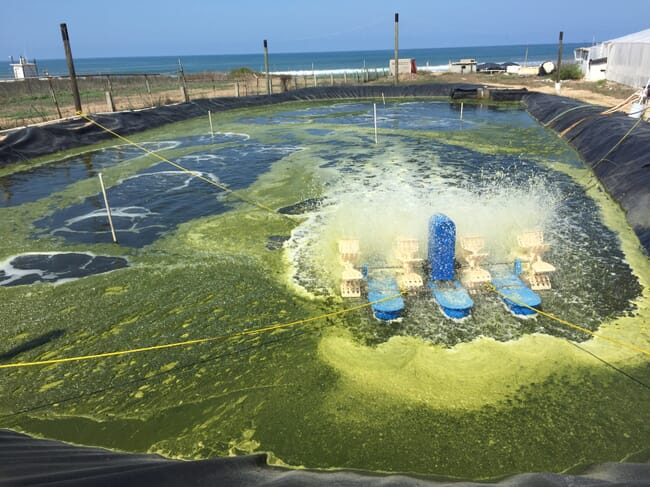
© Kurt Servin
Maintaining bacterial amendments
In order to maintain shrimp health, probiotics need to be added to the water body. This will create a competitive environment for opportunistic pathogens. The commonly used probiotics in shrimp farming are Bacillus sp, Lactobacillus sp, and Pseudomonas sp.
Reducing and replacing feed inputs
Feed is one of the main sources of ammonia in the water body. Consequently, when an ammonia problem appears, the amount of feed should be reduced by 30 to 40 percent. Besides, under high ammonia concentrations, shrimp appetite is reduced and feed reduction will prevent overfeeding.
Other than reduction, ammonia concentrations in culture water can be reduced by replacing the feed. Replacing the current feed with one containing lower nitrogen or protein content will reduce the nitrogen input to the water body.
Siphoning
Ammonia is released to the water body from the decomposition of organic load, which settles as sludges in the pond bottom. Siphoning can eliminate this leftover feed or any organic matter in the pond bottom. This decreases the concentration of ammonia and prevents further ammonia build-up from microbial decomposition.
Post-treatment and semi-RAS
A post-treatment pond is good practice, both to reduce environmental effluent loading and as a bio-controlled water exchange source. Post-treatment is primarily used to reduce the ammonia and pathogen concentrations released into the environment which helps to maintain local water quality and carrying capacity.
An alternate use of post-treatment ponds are to remediate the water and reduce ammonia concentrations, to then pump some of the water back into the grow out ponds. Post-treatment can be achieved in a number of ways from poly-cultured ponds with milkfish and seaweed to settling ponds, semi-mechanical processes and chemical treatment.
Use different strategies to manage ammonia
Ammonia is a significant limiting factor in shrimp production. Its build-up can reach toxic levels and affect shrimp health and water quality. This may lead to a reduction in farm productivity, economic losses and shrimp mortality.
However, ammonia build-up can be prevented by maintaining important water parameters – such as alkalinity, pH, salinity, and dissolved oxygen. Should an ammonia problem arise, there are countermeasures that could be implemented. This includes physical treatment, increasing nitrification rate and alkalinity, adding probiotics, maintaining a proper feeding regime and siphoning the pond.
Embracing up-to-date science, proper technology and expert support can help shrimp farmers manage their ammonia problems, while increasing productivity and profits.
The Alune farming experts will be sharing their experiences and research in regular articles on The Fish Site as part of the Closer to shrimp aquaculture series.
* The Fish Site is owned by Hatch, which has invested in Alune, but we remain editorially independent.

